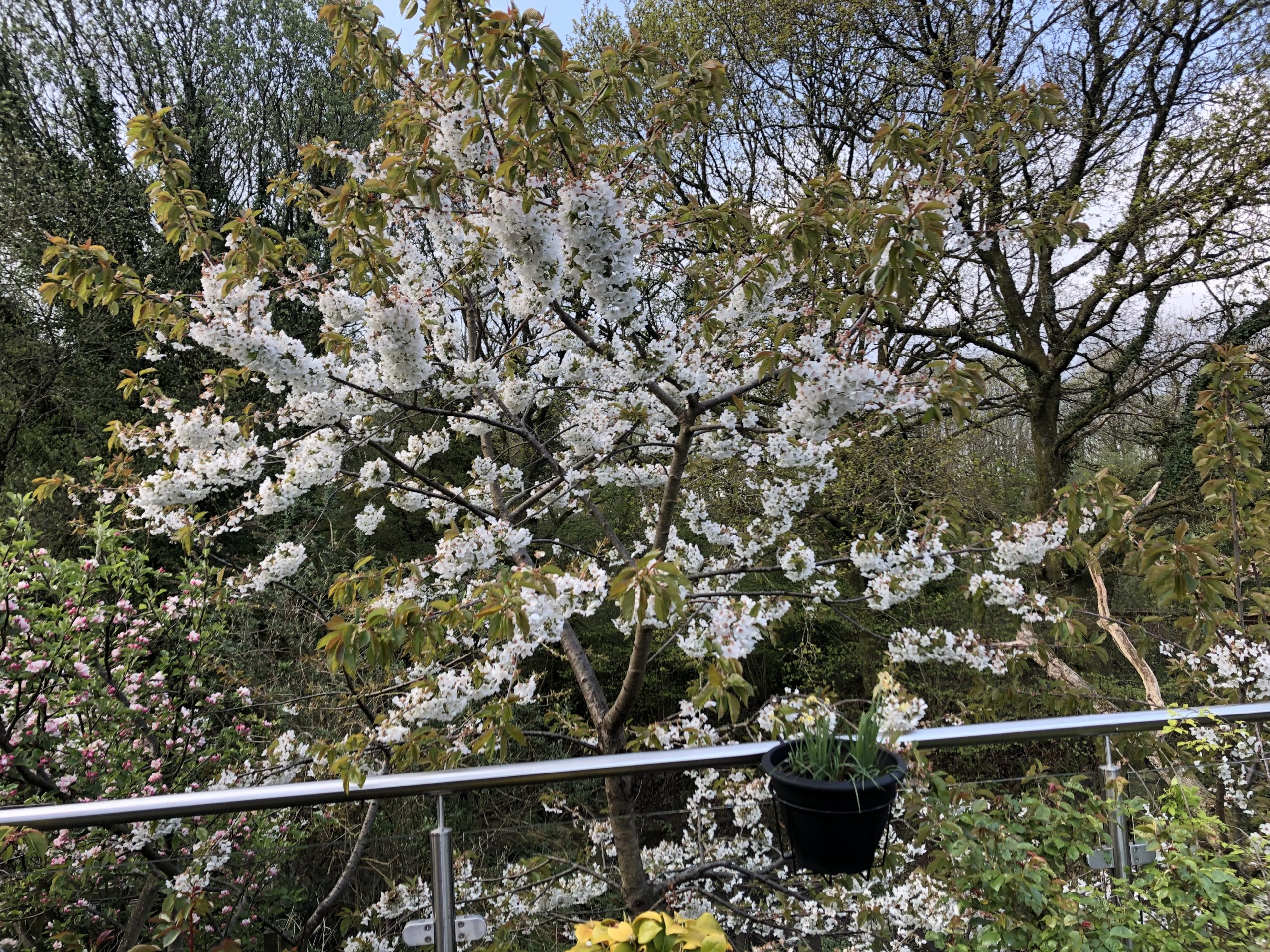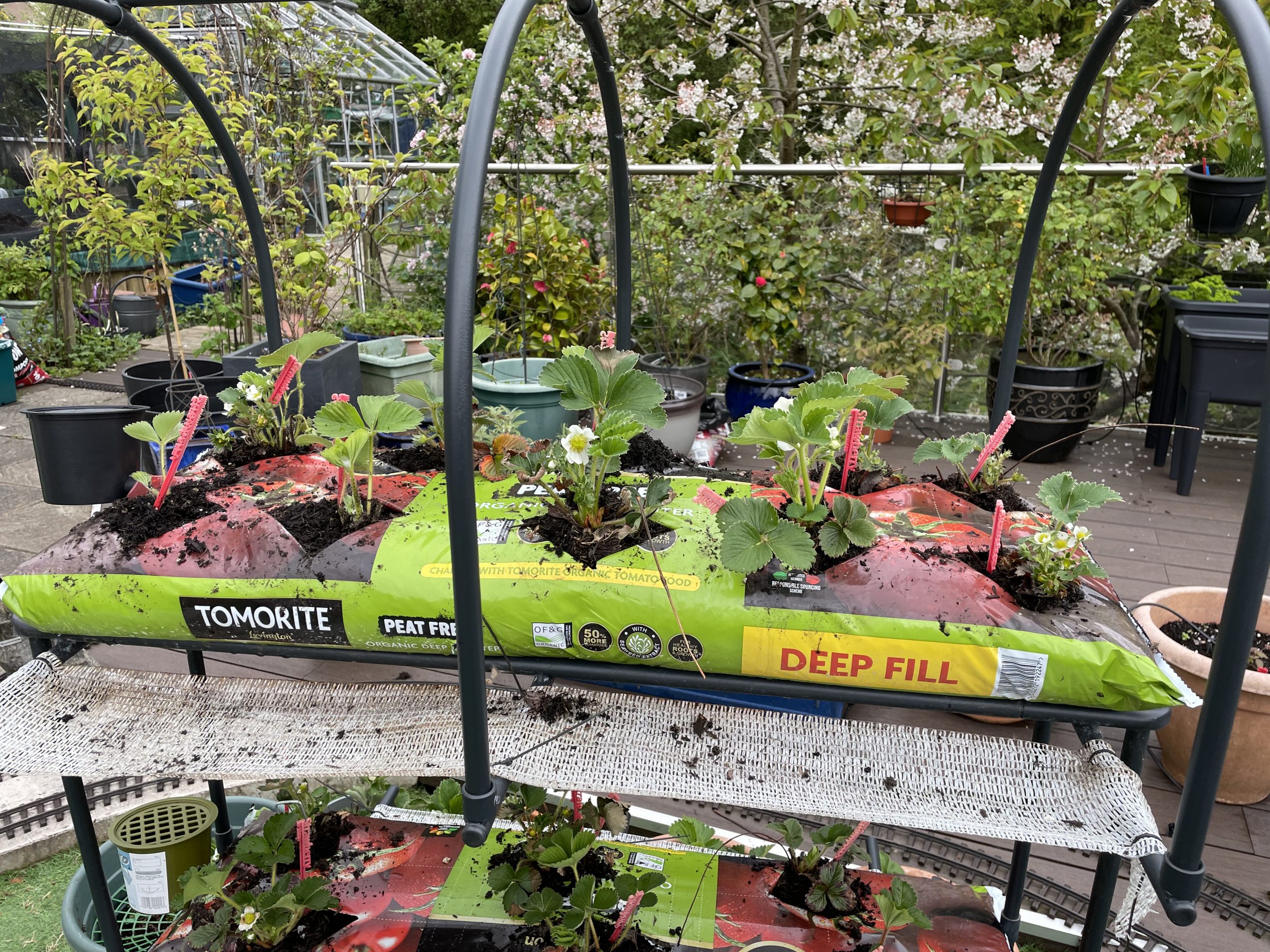Cherries, Raspberries, Rhubarb & Strawberries (June / July harvests)
4 August 2022Cherry
Cherry trees are one of the earliest blossoms and would be welcome in my garden if only for their beauty in spring time! The early blossom makes them a real benefit to the local pollinators too!

Although my space efficiency table only considers the soil area for one tree, you usually need an additional tree of a different cherry type for cross pollination, but you would get fruit off that tree too! A useful guide to varieties for cross pollination is available on https://www.primrose.co.uk/blog/2018/02/cherry-fruit-trees-pollination-varieties-guide/.
After pollination, the next trick is to protect and harvest the fruit. I live in an area with a thriving squirrel population, which makes this a challenge! Cherry trees tend to be big and tall (mine is over 5m tall) so I’ve planted my trees on a slope below a raised deck – this allows me to reach some of the lower branches of one tree. I think it’s a Stella (although it may be a Sunburst – I bought both in 2011 and the labels have bleached). You can get nets on poles to harvest fruit out of reach but that requires harvesting before the birds and squirrels get there. As I like properly ripe fruit and the birds/squirrels are happy to take them earlier, this is a problem! I use mesh sleeves and socks to protect branches I can reach. But the birds and squirrel’s usually get the cherries from the other branches – this explains the low mass yield for cherries compared to the other fruit in my table below – it would be much better if I could find a way to protect the fruit on the whole tree.

The main harvest for my cherry tree in South Wales is in July, although some fruit ripen towards the end of June. The harvest could be later in more northern areas and for other cherry varieties.

In 2020 a deluge of rain when the cherries were close to ripe caused several of the cherries to split – this pushed me to harvest as many cherries as I could quickly and make some jam – the squirrel was taken by surprise! This year, the squirrel learned to chew his way through the sleeves – this could make harvests even lower next year. I don’t blame the squirrel – those cherries are delicious!

If you don’t have much space, or you don’t fancy planting a big tree and letting the local wildlife have most of the fruit, then you can get “patio cherries” which will grow in a large pot. A useful guide to looking after potted cherry trees is available on https://www.gardeningknowhow.com/edible/fruits/cherry/growing-cherries-in-a-pot.htm#:~:text=Container%20grown%20cherry%20trees%20need,5%20foot%20(1.5%20m.)
Raspberry
This year I tried a patio raspberry called Yummy! This little beauty lives in a neat 40cm diameter and 30cm deep pot!

Surprisingly I didn’t need to protect the fruit (reasonably easy for a small plant like this)! Being able to harvest the majority of the fruit gives the raspberry a much higher mass yield than the cherries! I only obtained the plant this year, so I was surprised to get a harvest in July.

It often takes a few years for plants to establish so I have hopes it will perform as well or better next year! Different varieties can be chosen to get crops at different times through summer and early autumn.
Although the flowers aren’t showy, this is another plant which benefits pollinators.

Rhubarb
I was lucky to receive a donation of 2 rhubarb plants in February as a swap for some oca plantlets (link to my blog post on oca below!). By July they were both growing rampantly!

I wouldn’t normally harvest a plant so heavily, but a change of plan in the garden meant it was safer to harvest one of the plants than let it be trampled on while constructing a deck path (don’t worry the plant is already growing back!). These plants need a lot of space (1.5m diameter for mine) but have the benefit of being harvested as early as March or April and continuing throughout the summer.

Strawberry
The great advantage of growing your own strawberries is being able to choose for flavour rather than ability to withstand handling. Marshmellow strawberries are absolutely divine! The bulk of the crop ripens in June, with a few left over for July. I’m now looking for an equally tasty strawberry which ripens later in the summer.

My initial attempts to grow strawberries were using strawberry pots. Unfortunately, many of the “strawberry pots” sold don’t have a sufficient lip to hold water. Pretty much every attempt I made to water these washed out a lot of the compost. Eventually I settled on submerging the pot in a deep bucket of water – despite this I wasn’t able to keep the plants watered well enough to get much fruit.

When I received my Marshmellow strawberry plants, I tried some in ordinary pots and some in a grow bag on an elevated frame.


The elevated frame allows 10 plants each to be grown in 2 grow bags without increasing the footprint. It also lifts the strawberries above the slugs (enemy number 1!). The frame supports a net which protects the strawberries from birds (enemy number 2!). I only use the net after the fruit have started to develop. Before that they can deter pollinators and after the fruit is harvested there’s no benefit to having the net and there is a danger of insects or small birds getting trapped in it. I was able to use the net to protect the pots as well as the growbags. The lower deck of my grow frame (and some of the pots) contains some “Malling Centennial” plants which also have very nice fruit! The combination of the frame and the pots held about 30 plants in a very compact space!

The mass yield for the grow bags on the frame was only slightly better than the pots; however, more of the fruit from the pots were damaged (those darn slugs…), so I’m a fan of the frame even though I didn’t manage to get plants to survive the winter in the growbag – probably due to dehydration (the growbag cover doesn’t let rain in). I’ll pay more attention to watering the plants this winter. However, there had been plenty of runners which I planted up in little pots last autumn – they survived the winter to give me this summer’s plants, which might be another strategy.
I did have an attempt to grow strawberries using hydroponics in 2020 – this was a total disaster as the roots rotted away. This is probably because I was using Deep Water Culture (the same technique I used on cucumbers (see link to cucumber post below). If you fancy the hydroponic approach, the Nutrient film or Ebb and Flow techniques are recommended and you can find advice for this on https://horticulture.co.uk/strawberries/hydroponic/.
If growing and protecting strawberries sounds like too much hard work – try wild strawberries. However, beware – they spread easily! Partly by runners, but also by seeds – they will pop up all over the garden. I don’t mind this as they provide ground cover with pretty flowers in spring.

They’re beneficial for pollinators and they’re pretty easy to pull up when you want to use the ground for something else (although you’ll probably have to pull them up again in the future – probably why my husband does not like them!). The fruits are tiny but tasty! I know the birds eat some of these, but there seems to be plenty left for humans too! Although the mass yield for wild strawberries is fairly low, it’s balanced by the lack of effort required! They don’t even need a specific patch – they can grow amongst other established plants.

Space efficiency / value for money
| Crop | Year | Soil Area (m2) | Soil Depth (m) | Annual Harvest (kg) | Mass Yield (kg/m2.d) | £ Yield (£/m2.d) | Calorie Space* (m2) | Protein Space* (m2) |
| Cherry | 2020 | 12.42 | – | 1.298 | 0.00029 | 0.0025 | 11010 | 15875 |
| Cherry | 2021 | 12.42 | – | 0.143 | 0.00003 | 0.0003 | 99941 | 144097 |
| Cherry | 2022 | 12.42 | – | 0.817 | 0.0018 | 0.0016 | 14792 | 25221 |
| Raspberry | 2022 | 0.13 | 0.3 | 0.185 | 0.004 | 0.0538 | 992 | 1240 |
| Rhubarb | 2022 | 1.77 | – | 1.05 | 0.00163 | 0.0065 | 5350 | 3413 |
| Strawberries (pots) | 2022 | 0.34 | 0.15 | 0.645 | 0.00514 | 0.051 | 1217 | 1453 |
| Strawberries (growbag) | 2022 | 0.27 | 0.1 | 0.528 | 0.00536 | 0.0531 | 1166 | 1393 |
| Strawberries (wild) | 2022 | 0.65 | 0.05 | 0.107 | 0.00045 | 0.0045 | 13858 | 16547 |
From a purely economic view, strawberries and raspberries are the most cost effective to grow because you get good harvests from compact plants. However, the performance of the cherry tree would be much better if I could protect more of the harvest!